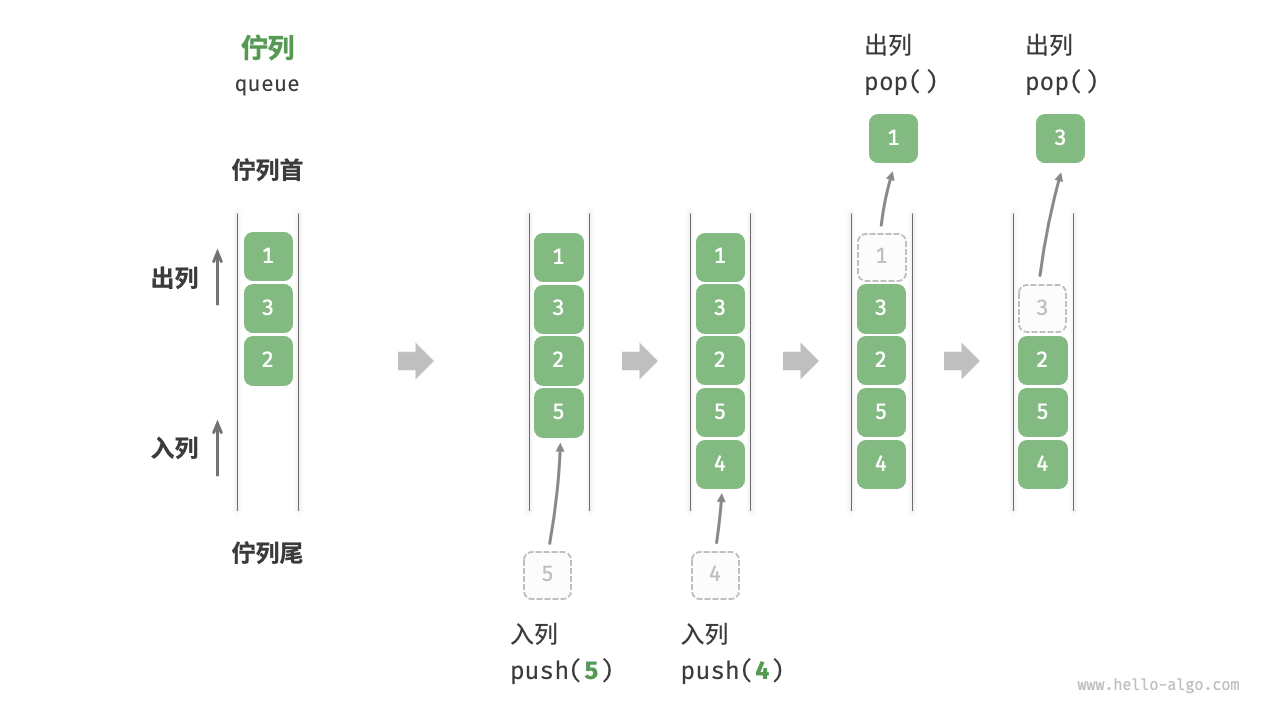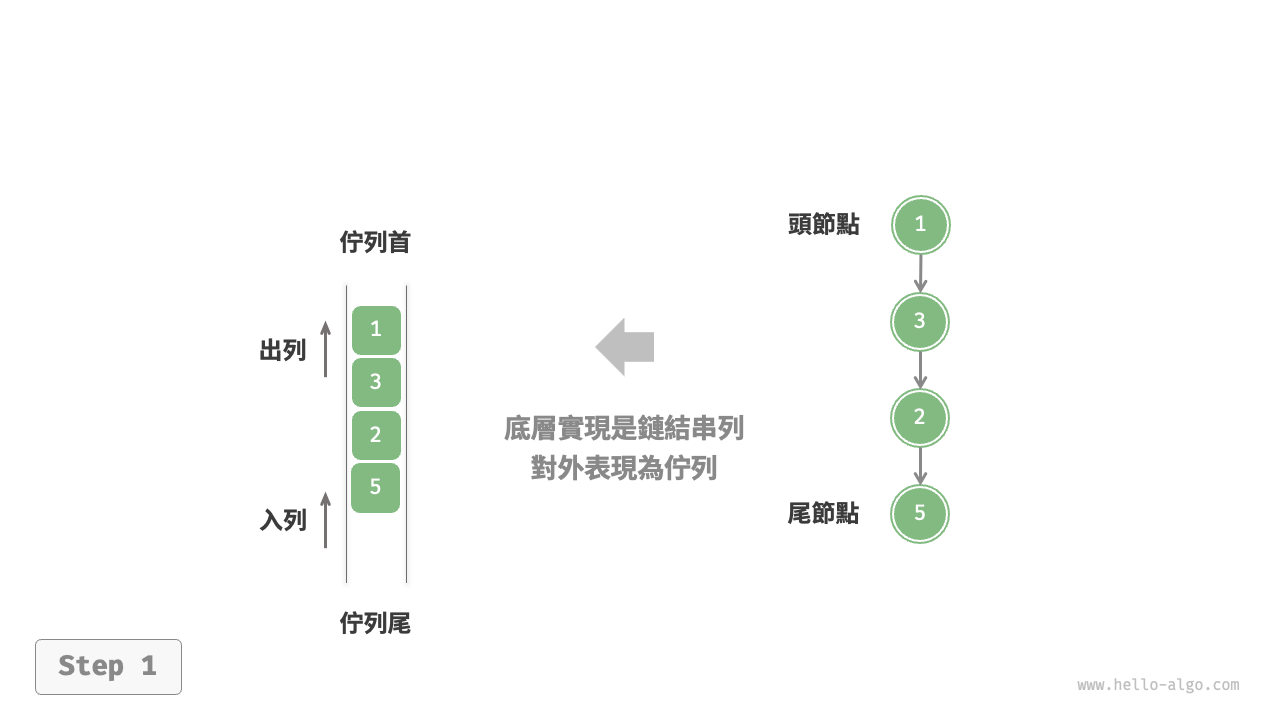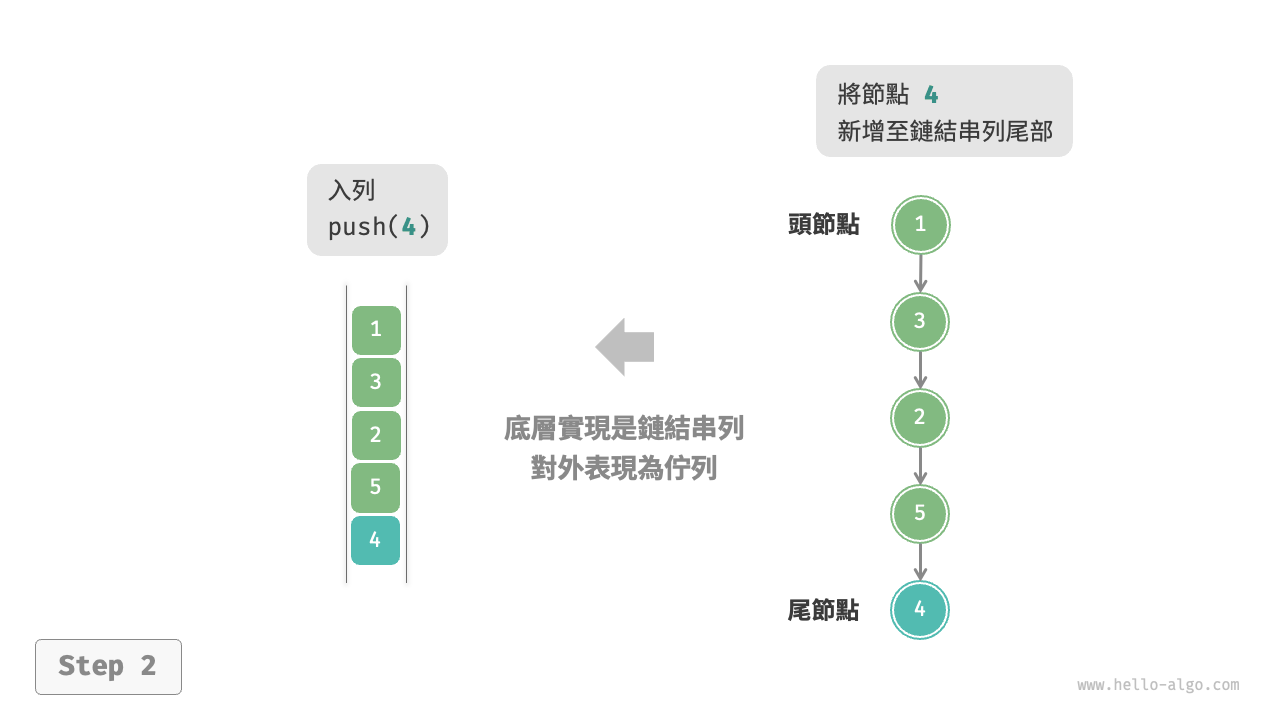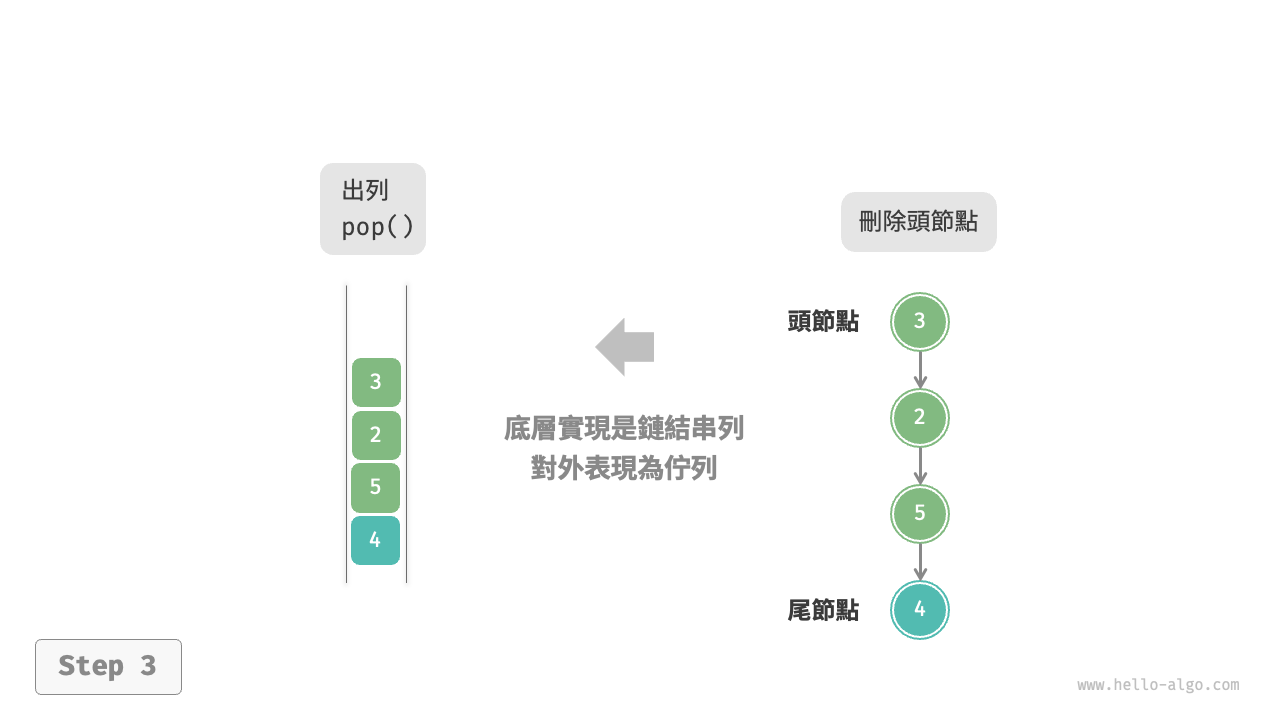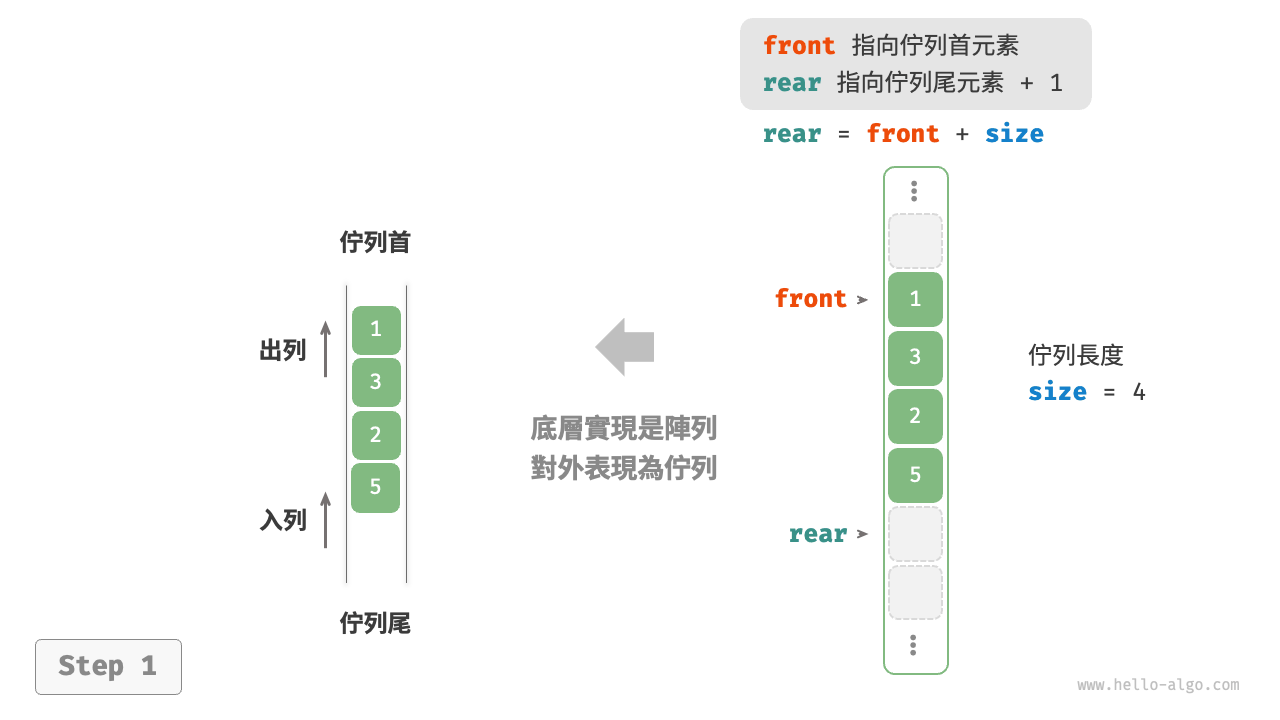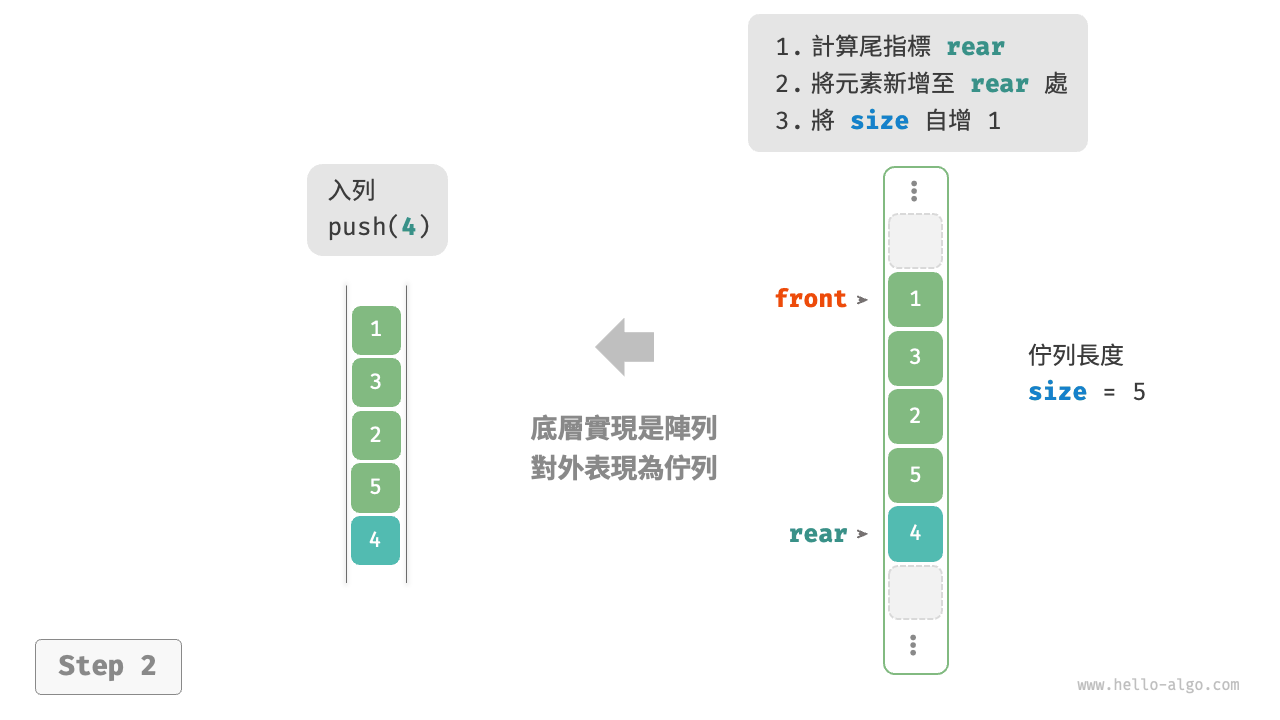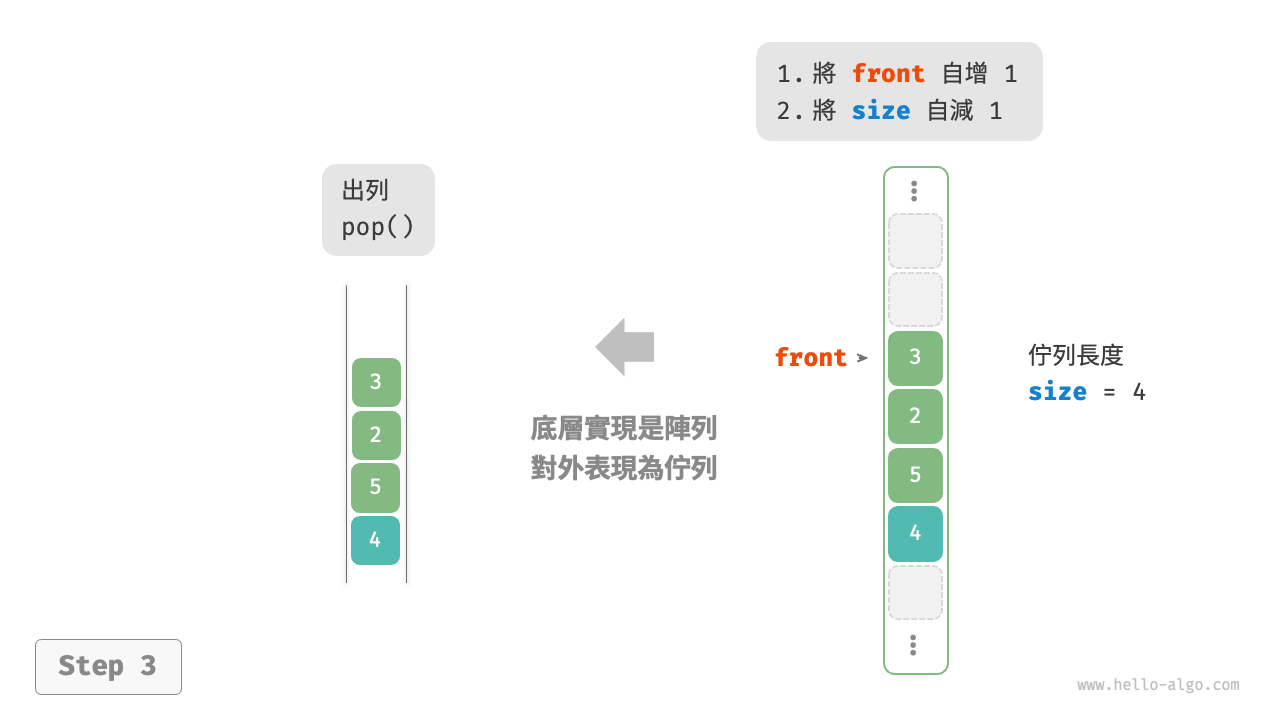5.2 佇列¶
佇列(queue)是一種遵循先入先出規則的線性資料結構。顧名思義,佇列模擬了排隊現象,即新來的人不斷加入佇列尾部,而位於佇列頭部的人逐個離開。
如圖 5-4 所示,我們將佇列頭部稱為“佇列首”,尾部稱為“佇列尾”,將把元素加入列尾的操作稱為“入列”,刪除佇列首元素的操作稱為“出列”。
圖 5-4 佇列的先入先出規則
5.2.1 佇列常用操作¶
佇列的常見操作如表 5-2 所示。需要注意的是,不同程式語言的方法名稱可能會有所不同。我們在此採用與堆疊相同的方法命名。
表 5-2 佇列操作效率
| 方法名 | 描述 | 時間複雜度 |
|---|---|---|
push() |
元素入列,即將元素新增至佇列尾 | \(O(1)\) |
pop() |
佇列首元素出列 | \(O(1)\) |
peek() |
訪問佇列首元素 | \(O(1)\) |
我們可以直接使用程式語言中現成的佇列類別:
from collections import deque
# 初始化佇列
# 在 Python 中,我們一般將雙向佇列類別 deque 當作佇列使用
# 雖然 queue.Queue() 是純正的佇列類別,但不太好用,因此不推薦
que: deque[int] = deque()
# 元素入列
que.append(1)
que.append(3)
que.append(2)
que.append(5)
que.append(4)
# 訪問佇列首元素
front: int = que[0]
# 元素出列
pop: int = que.popleft()
# 獲取佇列的長度
size: int = len(que)
# 判斷佇列是否為空
is_empty: bool = len(que) == 0
/* 初始化佇列 */
Queue<Integer> queue = new LinkedList<>();
/* 元素入列 */
queue.offer(1);
queue.offer(3);
queue.offer(2);
queue.offer(5);
queue.offer(4);
/* 訪問佇列首元素 */
int peek = queue.peek();
/* 元素出列 */
int pop = queue.poll();
/* 獲取佇列的長度 */
int size = queue.size();
/* 判斷佇列是否為空 */
boolean isEmpty = queue.isEmpty();
/* 初始化佇列 */
Queue<int> queue = new();
/* 元素入列 */
queue.Enqueue(1);
queue.Enqueue(3);
queue.Enqueue(2);
queue.Enqueue(5);
queue.Enqueue(4);
/* 訪問佇列首元素 */
int peek = queue.Peek();
/* 元素出列 */
int pop = queue.Dequeue();
/* 獲取佇列的長度 */
int size = queue.Count;
/* 判斷佇列是否為空 */
bool isEmpty = queue.Count == 0;
/* 初始化佇列 */
// 在 Go 中,將 list 作為佇列來使用
queue := list.New()
/* 元素入列 */
queue.PushBack(1)
queue.PushBack(3)
queue.PushBack(2)
queue.PushBack(5)
queue.PushBack(4)
/* 訪問佇列首元素 */
peek := queue.Front()
/* 元素出列 */
pop := queue.Front()
queue.Remove(pop)
/* 獲取佇列的長度 */
size := queue.Len()
/* 判斷佇列是否為空 */
isEmpty := queue.Len() == 0
/* 初始化佇列 */
// Swift 沒有內建的佇列類別,可以把 Array 當作佇列來使用
var queue: [Int] = []
/* 元素入列 */
queue.append(1)
queue.append(3)
queue.append(2)
queue.append(5)
queue.append(4)
/* 訪問佇列首元素 */
let peek = queue.first!
/* 元素出列 */
// 由於是陣列,因此 removeFirst 的複雜度為 O(n)
let pool = queue.removeFirst()
/* 獲取佇列的長度 */
let size = queue.count
/* 判斷佇列是否為空 */
let isEmpty = queue.isEmpty
/* 初始化佇列 */
// JavaScript 沒有內建的佇列,可以把 Array 當作佇列來使用
const queue = [];
/* 元素入列 */
queue.push(1);
queue.push(3);
queue.push(2);
queue.push(5);
queue.push(4);
/* 訪問佇列首元素 */
const peek = queue[0];
/* 元素出列 */
// 底層是陣列,因此 shift() 方法的時間複雜度為 O(n)
const pop = queue.shift();
/* 獲取佇列的長度 */
const size = queue.length;
/* 判斷佇列是否為空 */
const empty = queue.length === 0;
/* 初始化佇列 */
// TypeScript 沒有內建的佇列,可以把 Array 當作佇列來使用
const queue: number[] = [];
/* 元素入列 */
queue.push(1);
queue.push(3);
queue.push(2);
queue.push(5);
queue.push(4);
/* 訪問佇列首元素 */
const peek = queue[0];
/* 元素出列 */
// 底層是陣列,因此 shift() 方法的時間複雜度為 O(n)
const pop = queue.shift();
/* 獲取佇列的長度 */
const size = queue.length;
/* 判斷佇列是否為空 */
const empty = queue.length === 0;
/* 初始化佇列 */
// 在 Dart 中,佇列類別 Qeque 是雙向佇列,也可作為佇列使用
Queue<int> queue = Queue();
/* 元素入列 */
queue.add(1);
queue.add(3);
queue.add(2);
queue.add(5);
queue.add(4);
/* 訪問佇列首元素 */
int peek = queue.first;
/* 元素出列 */
int pop = queue.removeFirst();
/* 獲取佇列的長度 */
int size = queue.length;
/* 判斷佇列是否為空 */
bool isEmpty = queue.isEmpty;
/* 初始化雙向佇列 */
// 在 Rust 中使用雙向佇列作為普通佇列來使用
let mut deque: VecDeque<u32> = VecDeque::new();
/* 元素入列 */
deque.push_back(1);
deque.push_back(3);
deque.push_back(2);
deque.push_back(5);
deque.push_back(4);
/* 訪問佇列首元素 */
if let Some(front) = deque.front() {
}
/* 元素出列 */
if let Some(pop) = deque.pop_front() {
}
/* 獲取佇列的長度 */
let size = deque.len();
/* 判斷佇列是否為空 */
let is_empty = deque.is_empty();
# 初始化佇列
# Ruby 內建的佇列(Thread::Queue) 沒有 peek 和走訪方法,可以把 Array 當作佇列來使用
queue = []
# 元素入列
queue.push(1)
queue.push(3)
queue.push(2)
queue.push(5)
queue.push(4)
# 訪問佇列元素
peek = queue.first
# 元素出列
# 清注意,由於是陣列,Array#shift 方法時間複雜度為 O(n)
pop = queue.shift
# 獲取佇列的長度
size = queue.length
# 判斷佇列是否為空
is_empty = queue.empty?
視覺化執行
5.2.2 佇列實現¶
為了實現佇列,我們需要一種資料結構,可以在一端新增元素,並在另一端刪除元素,鏈結串列和陣列都符合要求。
1. 基於鏈結串列的實現¶
如圖 5-5 所示,我們可以將鏈結串列的“頭節點”和“尾節點”分別視為“佇列首”和“佇列尾”,規定佇列尾僅可新增節點,佇列首僅可刪除節點。
圖 5-5 基於鏈結串列實現佇列的入列出列操作
以下是用鏈結串列實現佇列的程式碼:
class LinkedListQueue:
"""基於鏈結串列實現的佇列"""
def __init__(self):
"""建構子"""
self._front: ListNode | None = None # 頭節點 front
self._rear: ListNode | None = None # 尾節點 rear
self._size: int = 0
def size(self) -> int:
"""獲取佇列的長度"""
return self._size
def is_empty(self) -> bool:
"""判斷佇列是否為空"""
return self._size == 0
def push(self, num: int):
"""入列"""
# 在尾節點後新增 num
node = ListNode(num)
# 如果佇列為空,則令頭、尾節點都指向該節點
if self._front is None:
self._front = node
self._rear = node
# 如果佇列不為空,則將該節點新增到尾節點後
else:
self._rear.next = node
self._rear = node
self._size += 1
def pop(self) -> int:
"""出列"""
num = self.peek()
# 刪除頭節點
self._front = self._front.next
self._size -= 1
return num
def peek(self) -> int:
"""訪問佇列首元素"""
if self.is_empty():
raise IndexError("佇列為空")
return self._front.val
def to_list(self) -> list[int]:
"""轉化為串列用於列印"""
queue = []
temp = self._front
while temp:
queue.append(temp.val)
temp = temp.next
return queue
/* 基於鏈結串列實現的佇列 */
class LinkedListQueue {
private:
ListNode *front, *rear; // 頭節點 front ,尾節點 rear
int queSize;
public:
LinkedListQueue() {
front = nullptr;
rear = nullptr;
queSize = 0;
}
~LinkedListQueue() {
// 走訪鏈結串列刪除節點,釋放記憶體
freeMemoryLinkedList(front);
}
/* 獲取佇列的長度 */
int size() {
return queSize;
}
/* 判斷佇列是否為空 */
bool isEmpty() {
return queSize == 0;
}
/* 入列 */
void push(int num) {
// 在尾節點後新增 num
ListNode *node = new ListNode(num);
// 如果佇列為空,則令頭、尾節點都指向該節點
if (front == nullptr) {
front = node;
rear = node;
}
// 如果佇列不為空,則將該節點新增到尾節點後
else {
rear->next = node;
rear = node;
}
queSize++;
}
/* 出列 */
int pop() {
int num = peek();
// 刪除頭節點
ListNode *tmp = front;
front = front->next;
// 釋放記憶體
delete tmp;
queSize--;
return num;
}
/* 訪問佇列首元素 */
int peek() {
if (size() == 0)
throw out_of_range("佇列為空");
return front->val;
}
/* 將鏈結串列轉化為 Vector 並返回 */
vector<int> toVector() {
ListNode *node = front;
vector<int> res(size());
for (int i = 0; i < res.size(); i++) {
res[i] = node->val;
node = node->next;
}
return res;
}
};
/* 基於鏈結串列實現的佇列 */
class LinkedListQueue {
private ListNode front, rear; // 頭節點 front ,尾節點 rear
private int queSize = 0;
public LinkedListQueue() {
front = null;
rear = null;
}
/* 獲取佇列的長度 */
public int size() {
return queSize;
}
/* 判斷佇列是否為空 */
public boolean isEmpty() {
return size() == 0;
}
/* 入列 */
public void push(int num) {
// 在尾節點後新增 num
ListNode node = new ListNode(num);
// 如果佇列為空,則令頭、尾節點都指向該節點
if (front == null) {
front = node;
rear = node;
// 如果佇列不為空,則將該節點新增到尾節點後
} else {
rear.next = node;
rear = node;
}
queSize++;
}
/* 出列 */
public int pop() {
int num = peek();
// 刪除頭節點
front = front.next;
queSize--;
return num;
}
/* 訪問佇列首元素 */
public int peek() {
if (isEmpty())
throw new IndexOutOfBoundsException();
return front.val;
}
/* 將鏈結串列轉化為 Array 並返回 */
public int[] toArray() {
ListNode node = front;
int[] res = new int[size()];
for (int i = 0; i < res.length; i++) {
res[i] = node.val;
node = node.next;
}
return res;
}
}
/* 基於鏈結串列實現的佇列 */
class LinkedListQueue {
ListNode? front, rear; // 頭節點 front ,尾節點 rear
int queSize = 0;
public LinkedListQueue() {
front = null;
rear = null;
}
/* 獲取佇列的長度 */
public int Size() {
return queSize;
}
/* 判斷佇列是否為空 */
public bool IsEmpty() {
return Size() == 0;
}
/* 入列 */
public void Push(int num) {
// 在尾節點後新增 num
ListNode node = new(num);
// 如果佇列為空,則令頭、尾節點都指向該節點
if (front == null) {
front = node;
rear = node;
// 如果佇列不為空,則將該節點新增到尾節點後
} else if (rear != null) {
rear.next = node;
rear = node;
}
queSize++;
}
/* 出列 */
public int Pop() {
int num = Peek();
// 刪除頭節點
front = front?.next;
queSize--;
return num;
}
/* 訪問佇列首元素 */
public int Peek() {
if (IsEmpty())
throw new Exception();
return front!.val;
}
/* 將鏈結串列轉化為 Array 並返回 */
public int[] ToArray() {
if (front == null)
return [];
ListNode? node = front;
int[] res = new int[Size()];
for (int i = 0; i < res.Length; i++) {
res[i] = node!.val;
node = node.next;
}
return res;
}
}
/* 基於鏈結串列實現的佇列 */
type linkedListQueue struct {
// 使用內建包 list 來實現佇列
data *list.List
}
/* 初始化佇列 */
func newLinkedListQueue() *linkedListQueue {
return &linkedListQueue{
data: list.New(),
}
}
/* 入列 */
func (s *linkedListQueue) push(value any) {
s.data.PushBack(value)
}
/* 出列 */
func (s *linkedListQueue) pop() any {
if s.isEmpty() {
return nil
}
e := s.data.Front()
s.data.Remove(e)
return e.Value
}
/* 訪問佇列首元素 */
func (s *linkedListQueue) peek() any {
if s.isEmpty() {
return nil
}
e := s.data.Front()
return e.Value
}
/* 獲取佇列的長度 */
func (s *linkedListQueue) size() int {
return s.data.Len()
}
/* 判斷佇列是否為空 */
func (s *linkedListQueue) isEmpty() bool {
return s.data.Len() == 0
}
/* 獲取 List 用於列印 */
func (s *linkedListQueue) toList() *list.List {
return s.data
}
/* 基於鏈結串列實現的佇列 */
class LinkedListQueue {
private var front: ListNode? // 頭節點
private var rear: ListNode? // 尾節點
private var _size: Int
init() {
_size = 0
}
/* 獲取佇列的長度 */
func size() -> Int {
_size
}
/* 判斷佇列是否為空 */
func isEmpty() -> Bool {
size() == 0
}
/* 入列 */
func push(num: Int) {
// 在尾節點後新增 num
let node = ListNode(x: num)
// 如果佇列為空,則令頭、尾節點都指向該節點
if front == nil {
front = node
rear = node
}
// 如果佇列不為空,則將該節點新增到尾節點後
else {
rear?.next = node
rear = node
}
_size += 1
}
/* 出列 */
@discardableResult
func pop() -> Int {
let num = peek()
// 刪除頭節點
front = front?.next
_size -= 1
return num
}
/* 訪問佇列首元素 */
func peek() -> Int {
if isEmpty() {
fatalError("佇列為空")
}
return front!.val
}
/* 將鏈結串列轉化為 Array 並返回 */
func toArray() -> [Int] {
var node = front
var res = Array(repeating: 0, count: size())
for i in res.indices {
res[i] = node!.val
node = node?.next
}
return res
}
}
/* 基於鏈結串列實現的佇列 */
class LinkedListQueue {
#front; // 頭節點 #front
#rear; // 尾節點 #rear
#queSize = 0;
constructor() {
this.#front = null;
this.#rear = null;
}
/* 獲取佇列的長度 */
get size() {
return this.#queSize;
}
/* 判斷佇列是否為空 */
isEmpty() {
return this.size === 0;
}
/* 入列 */
push(num) {
// 在尾節點後新增 num
const node = new ListNode(num);
// 如果佇列為空,則令頭、尾節點都指向該節點
if (!this.#front) {
this.#front = node;
this.#rear = node;
// 如果佇列不為空,則將該節點新增到尾節點後
} else {
this.#rear.next = node;
this.#rear = node;
}
this.#queSize++;
}
/* 出列 */
pop() {
const num = this.peek();
// 刪除頭節點
this.#front = this.#front.next;
this.#queSize--;
return num;
}
/* 訪問佇列首元素 */
peek() {
if (this.size === 0) throw new Error('佇列為空');
return this.#front.val;
}
/* 將鏈結串列轉化為 Array 並返回 */
toArray() {
let node = this.#front;
const res = new Array(this.size);
for (let i = 0; i < res.length; i++) {
res[i] = node.val;
node = node.next;
}
return res;
}
}
/* 基於鏈結串列實現的佇列 */
class LinkedListQueue {
private front: ListNode | null; // 頭節點 front
private rear: ListNode | null; // 尾節點 rear
private queSize: number = 0;
constructor() {
this.front = null;
this.rear = null;
}
/* 獲取佇列的長度 */
get size(): number {
return this.queSize;
}
/* 判斷佇列是否為空 */
isEmpty(): boolean {
return this.size === 0;
}
/* 入列 */
push(num: number): void {
// 在尾節點後新增 num
const node = new ListNode(num);
// 如果佇列為空,則令頭、尾節點都指向該節點
if (!this.front) {
this.front = node;
this.rear = node;
// 如果佇列不為空,則將該節點新增到尾節點後
} else {
this.rear!.next = node;
this.rear = node;
}
this.queSize++;
}
/* 出列 */
pop(): number {
const num = this.peek();
if (!this.front) throw new Error('佇列為空');
// 刪除頭節點
this.front = this.front.next;
this.queSize--;
return num;
}
/* 訪問佇列首元素 */
peek(): number {
if (this.size === 0) throw new Error('佇列為空');
return this.front!.val;
}
/* 將鏈結串列轉化為 Array 並返回 */
toArray(): number[] {
let node = this.front;
const res = new Array<number>(this.size);
for (let i = 0; i < res.length; i++) {
res[i] = node!.val;
node = node!.next;
}
return res;
}
}
/* 基於鏈結串列實現的佇列 */
class LinkedListQueue {
ListNode? _front; // 頭節點 _front
ListNode? _rear; // 尾節點 _rear
int _queSize = 0; // 佇列長度
LinkedListQueue() {
_front = null;
_rear = null;
}
/* 獲取佇列的長度 */
int size() {
return _queSize;
}
/* 判斷佇列是否為空 */
bool isEmpty() {
return _queSize == 0;
}
/* 入列 */
void push(int _num) {
// 在尾節點後新增 _num
final node = ListNode(_num);
// 如果佇列為空,則令頭、尾節點都指向該節點
if (_front == null) {
_front = node;
_rear = node;
} else {
// 如果佇列不為空,則將該節點新增到尾節點後
_rear!.next = node;
_rear = node;
}
_queSize++;
}
/* 出列 */
int pop() {
final int _num = peek();
// 刪除頭節點
_front = _front!.next;
_queSize--;
return _num;
}
/* 訪問佇列首元素 */
int peek() {
if (_queSize == 0) {
throw Exception('佇列為空');
}
return _front!.val;
}
/* 將鏈結串列轉化為 Array 並返回 */
List<int> toArray() {
ListNode? node = _front;
final List<int> queue = [];
while (node != null) {
queue.add(node.val);
node = node.next;
}
return queue;
}
}
/* 基於鏈結串列實現的佇列 */
#[allow(dead_code)]
pub struct LinkedListQueue<T> {
front: Option<Rc<RefCell<ListNode<T>>>>, // 頭節點 front
rear: Option<Rc<RefCell<ListNode<T>>>>, // 尾節點 rear
que_size: usize, // 佇列的長度
}
impl<T: Copy> LinkedListQueue<T> {
pub fn new() -> Self {
Self {
front: None,
rear: None,
que_size: 0,
}
}
/* 獲取佇列的長度 */
pub fn size(&self) -> usize {
return self.que_size;
}
/* 判斷佇列是否為空 */
pub fn is_empty(&self) -> bool {
return self.size() == 0;
}
/* 入列 */
pub fn push(&mut self, num: T) {
// 在尾節點後新增 num
let new_rear = ListNode::new(num);
match self.rear.take() {
// 如果佇列不為空,則將該節點新增到尾節點後
Some(old_rear) => {
old_rear.borrow_mut().next = Some(new_rear.clone());
self.rear = Some(new_rear);
}
// 如果佇列為空,則令頭、尾節點都指向該節點
None => {
self.front = Some(new_rear.clone());
self.rear = Some(new_rear);
}
}
self.que_size += 1;
}
/* 出列 */
pub fn pop(&mut self) -> Option<T> {
self.front.take().map(|old_front| {
match old_front.borrow_mut().next.take() {
Some(new_front) => {
self.front = Some(new_front);
}
None => {
self.rear.take();
}
}
self.que_size -= 1;
old_front.borrow().val
})
}
/* 訪問佇列首元素 */
pub fn peek(&self) -> Option<&Rc<RefCell<ListNode<T>>>> {
self.front.as_ref()
}
/* 將鏈結串列轉化為 Array 並返回 */
pub fn to_array(&self, head: Option<&Rc<RefCell<ListNode<T>>>>) -> Vec<T> {
let mut res: Vec<T> = Vec::new();
fn recur<T: Copy>(cur: Option<&Rc<RefCell<ListNode<T>>>>, res: &mut Vec<T>) {
if let Some(cur) = cur {
res.push(cur.borrow().val);
recur(cur.borrow().next.as_ref(), res);
}
}
recur(head, &mut res);
res
}
}
/* 基於鏈結串列實現的佇列 */
typedef struct {
ListNode *front, *rear;
int queSize;
} LinkedListQueue;
/* 建構子 */
LinkedListQueue *newLinkedListQueue() {
LinkedListQueue *queue = (LinkedListQueue *)malloc(sizeof(LinkedListQueue));
queue->front = NULL;
queue->rear = NULL;
queue->queSize = 0;
return queue;
}
/* 析構函式 */
void delLinkedListQueue(LinkedListQueue *queue) {
// 釋放所有節點
while (queue->front != NULL) {
ListNode *tmp = queue->front;
queue->front = queue->front->next;
free(tmp);
}
// 釋放 queue 結構體
free(queue);
}
/* 獲取佇列的長度 */
int size(LinkedListQueue *queue) {
return queue->queSize;
}
/* 判斷佇列是否為空 */
bool empty(LinkedListQueue *queue) {
return (size(queue) == 0);
}
/* 入列 */
void push(LinkedListQueue *queue, int num) {
// 尾節點處新增 node
ListNode *node = newListNode(num);
// 如果佇列為空,則令頭、尾節點都指向該節點
if (queue->front == NULL) {
queue->front = node;
queue->rear = node;
}
// 如果佇列不為空,則將該節點新增到尾節點後
else {
queue->rear->next = node;
queue->rear = node;
}
queue->queSize++;
}
/* 訪問佇列首元素 */
int peek(LinkedListQueue *queue) {
assert(size(queue) && queue->front);
return queue->front->val;
}
/* 出列 */
int pop(LinkedListQueue *queue) {
int num = peek(queue);
ListNode *tmp = queue->front;
queue->front = queue->front->next;
free(tmp);
queue->queSize--;
return num;
}
/* 列印佇列 */
void printLinkedListQueue(LinkedListQueue *queue) {
int *arr = malloc(sizeof(int) * queue->queSize);
// 複製鏈結串列中的資料到陣列
int i;
ListNode *node;
for (i = 0, node = queue->front; i < queue->queSize; i++) {
arr[i] = node->val;
node = node->next;
}
printArray(arr, queue->queSize);
free(arr);
}
/* 基於鏈結串列實現的佇列 */
class LinkedListQueue(
// 頭節點 front ,尾節點 rear
private var front: ListNode? = null,
private var rear: ListNode? = null,
private var queSize: Int = 0
) {
/* 獲取佇列的長度 */
fun size(): Int {
return queSize
}
/* 判斷佇列是否為空 */
fun isEmpty(): Boolean {
return size() == 0
}
/* 入列 */
fun push(num: Int) {
// 在尾節點後新增 num
val node = ListNode(num)
// 如果佇列為空,則令頭、尾節點都指向該節點
if (front == null) {
front = node
rear = node
// 如果佇列不為空,則將該節點新增到尾節點後
} else {
rear?.next = node
rear = node
}
queSize++
}
/* 出列 */
fun pop(): Int {
val num = peek()
// 刪除頭節點
front = front?.next
queSize--
return num
}
/* 訪問佇列首元素 */
fun peek(): Int {
if (isEmpty()) throw IndexOutOfBoundsException()
return front!!._val
}
/* 將鏈結串列轉化為 Array 並返回 */
fun toArray(): IntArray {
var node = front
val res = IntArray(size())
for (i in res.indices) {
res[i] = node!!._val
node = node.next
}
return res
}
}
### 基於鏈結串列頭現的佇列 ###
class LinkedListQueue
### 獲取佇列的長度 ###
attr_reader :size
### 建構子 ###
def initialize
@front = nil # 頭節點 front
@rear = nil # 尾節點 rear
@size = 0
end
### 判斷佇列是否為空 ###
def is_empty?
@front.nil?
end
### 入列 ###
def push(num)
# 在尾節點後新增 num
node = ListNode.new(num)
# 如果佇列為空,則令頭,尾節點都指向該節點
if @front.nil?
@front = node
@rear = node
# 如果佇列不為空,則令該節點新增到尾節點後
else
@rear.next = node
@rear = node
end
@size += 1
end
### 出列 ###
def pop
num = peek
# 刪除頭節點
@front = @front.next
@size -= 1
num
end
### 訪問佇列首元素 ###
def peek
raise IndexError, '佇列為空' if is_empty?
@front.val
end
### 將鏈結串列為 Array 並返回 ###
def to_array
queue = []
temp = @front
while temp
queue << temp.val
temp = temp.next
end
queue
end
end
// 基於鏈結串列實現的佇列
fn LinkedListQueue(comptime T: type) type {
return struct {
const Self = @This();
front: ?*inc.ListNode(T) = null, // 頭節點 front
rear: ?*inc.ListNode(T) = null, // 尾節點 rear
que_size: usize = 0, // 佇列的長度
mem_arena: ?std.heap.ArenaAllocator = null,
mem_allocator: std.mem.Allocator = undefined, // 記憶體分配器
// 建構子(分配記憶體+初始化佇列)
pub fn init(self: *Self, allocator: std.mem.Allocator) !void {
if (self.mem_arena == null) {
self.mem_arena = std.heap.ArenaAllocator.init(allocator);
self.mem_allocator = self.mem_arena.?.allocator();
}
self.front = null;
self.rear = null;
self.que_size = 0;
}
// 析構函式(釋放記憶體)
pub fn deinit(self: *Self) void {
if (self.mem_arena == null) return;
self.mem_arena.?.deinit();
}
// 獲取佇列的長度
pub fn size(self: *Self) usize {
return self.que_size;
}
// 判斷佇列是否為空
pub fn isEmpty(self: *Self) bool {
return self.size() == 0;
}
// 訪問佇列首元素
pub fn peek(self: *Self) T {
if (self.size() == 0) @panic("佇列為空");
return self.front.?.val;
}
// 入列
pub fn push(self: *Self, num: T) !void {
// 在尾節點後新增 num
var node = try self.mem_allocator.create(inc.ListNode(T));
node.init(num);
// 如果佇列為空,則令頭、尾節點都指向該節點
if (self.front == null) {
self.front = node;
self.rear = node;
// 如果佇列不為空,則將該節點新增到尾節點後
} else {
self.rear.?.next = node;
self.rear = node;
}
self.que_size += 1;
}
// 出列
pub fn pop(self: *Self) T {
var num = self.peek();
// 刪除頭節點
self.front = self.front.?.next;
self.que_size -= 1;
return num;
}
// 將鏈結串列轉換為陣列
pub fn toArray(self: *Self) ![]T {
var node = self.front;
var res = try self.mem_allocator.alloc(T, self.size());
@memset(res, @as(T, 0));
var i: usize = 0;
while (i < res.len) : (i += 1) {
res[i] = node.?.val;
node = node.?.next;
}
return res;
}
};
}
視覺化執行
2. 基於陣列的實現¶
在陣列中刪除首元素的時間複雜度為 \(O(n)\) ,這會導致出列操作效率較低。然而,我們可以採用以下巧妙方法來避免這個問題。
我們可以使用一個變數 front 指向佇列首元素的索引,並維護一個變數 size 用於記錄佇列長度。定義 rear = front + size ,這個公式計算出的 rear 指向佇列尾元素之後的下一個位置。
基於此設計,陣列中包含元素的有效區間為 [front, rear - 1],各種操作的實現方法如圖 5-6 所示。
- 入列操作:將輸入元素賦值給
rear索引處,並將size增加 1 。 - 出列操作:只需將
front增加 1 ,並將size減少 1 。
可以看到,入列和出列操作都只需進行一次操作,時間複雜度均為 \(O(1)\) 。
圖 5-6 基於陣列實現佇列的入列出列操作
你可能會發現一個問題:在不斷進行入列和出列的過程中,front 和 rear 都在向右移動,當它們到達陣列尾部時就無法繼續移動了。為了解決此問題,我們可以將陣列視為首尾相接的“環形陣列”。
對於環形陣列,我們需要讓 front 或 rear 在越過陣列尾部時,直接回到陣列頭部繼續走訪。這種週期性規律可以透過“取餘操作”來實現,程式碼如下所示:
class ArrayQueue:
"""基於環形陣列實現的佇列"""
def __init__(self, size: int):
"""建構子"""
self._nums: list[int] = [0] * size # 用於儲存佇列元素的陣列
self._front: int = 0 # 佇列首指標,指向佇列首元素
self._size: int = 0 # 佇列長度
def capacity(self) -> int:
"""獲取佇列的容量"""
return len(self._nums)
def size(self) -> int:
"""獲取佇列的長度"""
return self._size
def is_empty(self) -> bool:
"""判斷佇列是否為空"""
return self._size == 0
def push(self, num: int):
"""入列"""
if self._size == self.capacity():
raise IndexError("佇列已滿")
# 計算佇列尾指標,指向佇列尾索引 + 1
# 透過取餘操作實現 rear 越過陣列尾部後回到頭部
rear: int = (self._front + self._size) % self.capacity()
# 將 num 新增至佇列尾
self._nums[rear] = num
self._size += 1
def pop(self) -> int:
"""出列"""
num: int = self.peek()
# 佇列首指標向後移動一位,若越過尾部,則返回到陣列頭部
self._front = (self._front + 1) % self.capacity()
self._size -= 1
return num
def peek(self) -> int:
"""訪問佇列首元素"""
if self.is_empty():
raise IndexError("佇列為空")
return self._nums[self._front]
def to_list(self) -> list[int]:
"""返回串列用於列印"""
res = [0] * self.size()
j: int = self._front
for i in range(self.size()):
res[i] = self._nums[(j % self.capacity())]
j += 1
return res
/* 基於環形陣列實現的佇列 */
class ArrayQueue {
private:
int *nums; // 用於儲存佇列元素的陣列
int front; // 佇列首指標,指向佇列首元素
int queSize; // 佇列長度
int queCapacity; // 佇列容量
public:
ArrayQueue(int capacity) {
// 初始化陣列
nums = new int[capacity];
queCapacity = capacity;
front = queSize = 0;
}
~ArrayQueue() {
delete[] nums;
}
/* 獲取佇列的容量 */
int capacity() {
return queCapacity;
}
/* 獲取佇列的長度 */
int size() {
return queSize;
}
/* 判斷佇列是否為空 */
bool isEmpty() {
return size() == 0;
}
/* 入列 */
void push(int num) {
if (queSize == queCapacity) {
cout << "佇列已滿" << endl;
return;
}
// 計算佇列尾指標,指向佇列尾索引 + 1
// 透過取餘操作實現 rear 越過陣列尾部後回到頭部
int rear = (front + queSize) % queCapacity;
// 將 num 新增至佇列尾
nums[rear] = num;
queSize++;
}
/* 出列 */
int pop() {
int num = peek();
// 佇列首指標向後移動一位,若越過尾部,則返回到陣列頭部
front = (front + 1) % queCapacity;
queSize--;
return num;
}
/* 訪問佇列首元素 */
int peek() {
if (isEmpty())
throw out_of_range("佇列為空");
return nums[front];
}
/* 將陣列轉化為 Vector 並返回 */
vector<int> toVector() {
// 僅轉換有效長度範圍內的串列元素
vector<int> arr(queSize);
for (int i = 0, j = front; i < queSize; i++, j++) {
arr[i] = nums[j % queCapacity];
}
return arr;
}
};
/* 基於環形陣列實現的佇列 */
class ArrayQueue {
private int[] nums; // 用於儲存佇列元素的陣列
private int front; // 佇列首指標,指向佇列首元素
private int queSize; // 佇列長度
public ArrayQueue(int capacity) {
nums = new int[capacity];
front = queSize = 0;
}
/* 獲取佇列的容量 */
public int capacity() {
return nums.length;
}
/* 獲取佇列的長度 */
public int size() {
return queSize;
}
/* 判斷佇列是否為空 */
public boolean isEmpty() {
return queSize == 0;
}
/* 入列 */
public void push(int num) {
if (queSize == capacity()) {
System.out.println("佇列已滿");
return;
}
// 計算佇列尾指標,指向佇列尾索引 + 1
// 透過取餘操作實現 rear 越過陣列尾部後回到頭部
int rear = (front + queSize) % capacity();
// 將 num 新增至佇列尾
nums[rear] = num;
queSize++;
}
/* 出列 */
public int pop() {
int num = peek();
// 佇列首指標向後移動一位,若越過尾部,則返回到陣列頭部
front = (front + 1) % capacity();
queSize--;
return num;
}
/* 訪問佇列首元素 */
public int peek() {
if (isEmpty())
throw new IndexOutOfBoundsException();
return nums[front];
}
/* 返回陣列 */
public int[] toArray() {
// 僅轉換有效長度範圍內的串列元素
int[] res = new int[queSize];
for (int i = 0, j = front; i < queSize; i++, j++) {
res[i] = nums[j % capacity()];
}
return res;
}
}
/* 基於環形陣列實現的佇列 */
class ArrayQueue {
int[] nums; // 用於儲存佇列元素的陣列
int front; // 佇列首指標,指向佇列首元素
int queSize; // 佇列長度
public ArrayQueue(int capacity) {
nums = new int[capacity];
front = queSize = 0;
}
/* 獲取佇列的容量 */
int Capacity() {
return nums.Length;
}
/* 獲取佇列的長度 */
public int Size() {
return queSize;
}
/* 判斷佇列是否為空 */
public bool IsEmpty() {
return queSize == 0;
}
/* 入列 */
public void Push(int num) {
if (queSize == Capacity()) {
Console.WriteLine("佇列已滿");
return;
}
// 計算佇列尾指標,指向佇列尾索引 + 1
// 透過取餘操作實現 rear 越過陣列尾部後回到頭部
int rear = (front + queSize) % Capacity();
// 將 num 新增至佇列尾
nums[rear] = num;
queSize++;
}
/* 出列 */
public int Pop() {
int num = Peek();
// 佇列首指標向後移動一位,若越過尾部,則返回到陣列頭部
front = (front + 1) % Capacity();
queSize--;
return num;
}
/* 訪問佇列首元素 */
public int Peek() {
if (IsEmpty())
throw new Exception();
return nums[front];
}
/* 返回陣列 */
public int[] ToArray() {
// 僅轉換有效長度範圍內的串列元素
int[] res = new int[queSize];
for (int i = 0, j = front; i < queSize; i++, j++) {
res[i] = nums[j % this.Capacity()];
}
return res;
}
}
/* 基於環形陣列實現的佇列 */
type arrayQueue struct {
nums []int // 用於儲存佇列元素的陣列
front int // 佇列首指標,指向佇列首元素
queSize int // 佇列長度
queCapacity int // 佇列容量(即最大容納元素數量)
}
/* 初始化佇列 */
func newArrayQueue(queCapacity int) *arrayQueue {
return &arrayQueue{
nums: make([]int, queCapacity),
queCapacity: queCapacity,
front: 0,
queSize: 0,
}
}
/* 獲取佇列的長度 */
func (q *arrayQueue) size() int {
return q.queSize
}
/* 判斷佇列是否為空 */
func (q *arrayQueue) isEmpty() bool {
return q.queSize == 0
}
/* 入列 */
func (q *arrayQueue) push(num int) {
// 當 rear == queCapacity 表示佇列已滿
if q.queSize == q.queCapacity {
return
}
// 計算佇列尾指標,指向佇列尾索引 + 1
// 透過取餘操作實現 rear 越過陣列尾部後回到頭部
rear := (q.front + q.queSize) % q.queCapacity
// 將 num 新增至佇列尾
q.nums[rear] = num
q.queSize++
}
/* 出列 */
func (q *arrayQueue) pop() any {
num := q.peek()
if num == nil {
return nil
}
// 佇列首指標向後移動一位,若越過尾部,則返回到陣列頭部
q.front = (q.front + 1) % q.queCapacity
q.queSize--
return num
}
/* 訪問佇列首元素 */
func (q *arrayQueue) peek() any {
if q.isEmpty() {
return nil
}
return q.nums[q.front]
}
/* 獲取 Slice 用於列印 */
func (q *arrayQueue) toSlice() []int {
rear := (q.front + q.queSize)
if rear >= q.queCapacity {
rear %= q.queCapacity
return append(q.nums[q.front:], q.nums[:rear]...)
}
return q.nums[q.front:rear]
}
/* 基於環形陣列實現的佇列 */
class ArrayQueue {
private var nums: [Int] // 用於儲存佇列元素的陣列
private var front: Int // 佇列首指標,指向佇列首元素
private var _size: Int // 佇列長度
init(capacity: Int) {
// 初始化陣列
nums = Array(repeating: 0, count: capacity)
front = 0
_size = 0
}
/* 獲取佇列的容量 */
func capacity() -> Int {
nums.count
}
/* 獲取佇列的長度 */
func size() -> Int {
_size
}
/* 判斷佇列是否為空 */
func isEmpty() -> Bool {
size() == 0
}
/* 入列 */
func push(num: Int) {
if size() == capacity() {
print("佇列已滿")
return
}
// 計算佇列尾指標,指向佇列尾索引 + 1
// 透過取餘操作實現 rear 越過陣列尾部後回到頭部
let rear = (front + size()) % capacity()
// 將 num 新增至佇列尾
nums[rear] = num
_size += 1
}
/* 出列 */
@discardableResult
func pop() -> Int {
let num = peek()
// 佇列首指標向後移動一位,若越過尾部,則返回到陣列頭部
front = (front + 1) % capacity()
_size -= 1
return num
}
/* 訪問佇列首元素 */
func peek() -> Int {
if isEmpty() {
fatalError("佇列為空")
}
return nums[front]
}
/* 返回陣列 */
func toArray() -> [Int] {
// 僅轉換有效長度範圍內的串列元素
(front ..< front + size()).map { nums[$0 % capacity()] }
}
}
/* 基於環形陣列實現的佇列 */
class ArrayQueue {
#nums; // 用於儲存佇列元素的陣列
#front = 0; // 佇列首指標,指向佇列首元素
#queSize = 0; // 佇列長度
constructor(capacity) {
this.#nums = new Array(capacity);
}
/* 獲取佇列的容量 */
get capacity() {
return this.#nums.length;
}
/* 獲取佇列的長度 */
get size() {
return this.#queSize;
}
/* 判斷佇列是否為空 */
isEmpty() {
return this.#queSize === 0;
}
/* 入列 */
push(num) {
if (this.size === this.capacity) {
console.log('佇列已滿');
return;
}
// 計算佇列尾指標,指向佇列尾索引 + 1
// 透過取餘操作實現 rear 越過陣列尾部後回到頭部
const rear = (this.#front + this.size) % this.capacity;
// 將 num 新增至佇列尾
this.#nums[rear] = num;
this.#queSize++;
}
/* 出列 */
pop() {
const num = this.peek();
// 佇列首指標向後移動一位,若越過尾部,則返回到陣列頭部
this.#front = (this.#front + 1) % this.capacity;
this.#queSize--;
return num;
}
/* 訪問佇列首元素 */
peek() {
if (this.isEmpty()) throw new Error('佇列為空');
return this.#nums[this.#front];
}
/* 返回 Array */
toArray() {
// 僅轉換有效長度範圍內的串列元素
const arr = new Array(this.size);
for (let i = 0, j = this.#front; i < this.size; i++, j++) {
arr[i] = this.#nums[j % this.capacity];
}
return arr;
}
}
/* 基於環形陣列實現的佇列 */
class ArrayQueue {
private nums: number[]; // 用於儲存佇列元素的陣列
private front: number; // 佇列首指標,指向佇列首元素
private queSize: number; // 佇列長度
constructor(capacity: number) {
this.nums = new Array(capacity);
this.front = this.queSize = 0;
}
/* 獲取佇列的容量 */
get capacity(): number {
return this.nums.length;
}
/* 獲取佇列的長度 */
get size(): number {
return this.queSize;
}
/* 判斷佇列是否為空 */
isEmpty(): boolean {
return this.queSize === 0;
}
/* 入列 */
push(num: number): void {
if (this.size === this.capacity) {
console.log('佇列已滿');
return;
}
// 計算佇列尾指標,指向佇列尾索引 + 1
// 透過取餘操作實現 rear 越過陣列尾部後回到頭部
const rear = (this.front + this.queSize) % this.capacity;
// 將 num 新增至佇列尾
this.nums[rear] = num;
this.queSize++;
}
/* 出列 */
pop(): number {
const num = this.peek();
// 佇列首指標向後移動一位,若越過尾部,則返回到陣列頭部
this.front = (this.front + 1) % this.capacity;
this.queSize--;
return num;
}
/* 訪問佇列首元素 */
peek(): number {
if (this.isEmpty()) throw new Error('佇列為空');
return this.nums[this.front];
}
/* 返回 Array */
toArray(): number[] {
// 僅轉換有效長度範圍內的串列元素
const arr = new Array(this.size);
for (let i = 0, j = this.front; i < this.size; i++, j++) {
arr[i] = this.nums[j % this.capacity];
}
return arr;
}
}
/* 基於環形陣列實現的佇列 */
class ArrayQueue {
late List<int> _nums; // 用於儲存佇列元素的陣列
late int _front; // 佇列首指標,指向佇列首元素
late int _queSize; // 佇列長度
ArrayQueue(int capacity) {
_nums = List.filled(capacity, 0);
_front = _queSize = 0;
}
/* 獲取佇列的容量 */
int capaCity() {
return _nums.length;
}
/* 獲取佇列的長度 */
int size() {
return _queSize;
}
/* 判斷佇列是否為空 */
bool isEmpty() {
return _queSize == 0;
}
/* 入列 */
void push(int _num) {
if (_queSize == capaCity()) {
throw Exception("佇列已滿");
}
// 計算佇列尾指標,指向佇列尾索引 + 1
// 透過取餘操作實現 rear 越過陣列尾部後回到頭部
int rear = (_front + _queSize) % capaCity();
// 將 _num 新增至佇列尾
_nums[rear] = _num;
_queSize++;
}
/* 出列 */
int pop() {
int _num = peek();
// 佇列首指標向後移動一位,若越過尾部,則返回到陣列頭部
_front = (_front + 1) % capaCity();
_queSize--;
return _num;
}
/* 訪問佇列首元素 */
int peek() {
if (isEmpty()) {
throw Exception("佇列為空");
}
return _nums[_front];
}
/* 返回 Array */
List<int> toArray() {
// 僅轉換有效長度範圍內的串列元素
final List<int> res = List.filled(_queSize, 0);
for (int i = 0, j = _front; i < _queSize; i++, j++) {
res[i] = _nums[j % capaCity()];
}
return res;
}
}
/* 基於環形陣列實現的佇列 */
struct ArrayQueue {
nums: Vec<i32>, // 用於儲存佇列元素的陣列
front: i32, // 佇列首指標,指向佇列首元素
que_size: i32, // 佇列長度
que_capacity: i32, // 佇列容量
}
impl ArrayQueue {
/* 建構子 */
fn new(capacity: i32) -> ArrayQueue {
ArrayQueue {
nums: vec![0; capacity as usize],
front: 0,
que_size: 0,
que_capacity: capacity,
}
}
/* 獲取佇列的容量 */
fn capacity(&self) -> i32 {
self.que_capacity
}
/* 獲取佇列的長度 */
fn size(&self) -> i32 {
self.que_size
}
/* 判斷佇列是否為空 */
fn is_empty(&self) -> bool {
self.que_size == 0
}
/* 入列 */
fn push(&mut self, num: i32) {
if self.que_size == self.capacity() {
println!("佇列已滿");
return;
}
// 計算佇列尾指標,指向佇列尾索引 + 1
// 透過取餘操作實現 rear 越過陣列尾部後回到頭部
let rear = (self.front + self.que_size) % self.que_capacity;
// 將 num 新增至佇列尾
self.nums[rear as usize] = num;
self.que_size += 1;
}
/* 出列 */
fn pop(&mut self) -> i32 {
let num = self.peek();
// 佇列首指標向後移動一位,若越過尾部,則返回到陣列頭部
self.front = (self.front + 1) % self.que_capacity;
self.que_size -= 1;
num
}
/* 訪問佇列首元素 */
fn peek(&self) -> i32 {
if self.is_empty() {
panic!("index out of bounds");
}
self.nums[self.front as usize]
}
/* 返回陣列 */
fn to_vector(&self) -> Vec<i32> {
let cap = self.que_capacity;
let mut j = self.front;
let mut arr = vec![0; self.que_size as usize];
for i in 0..self.que_size {
arr[i as usize] = self.nums[(j % cap) as usize];
j += 1;
}
arr
}
}
/* 基於環形陣列實現的佇列 */
typedef struct {
int *nums; // 用於儲存佇列元素的陣列
int front; // 佇列首指標,指向佇列首元素
int queSize; // 尾指標,指向佇列尾 + 1
int queCapacity; // 佇列容量
} ArrayQueue;
/* 建構子 */
ArrayQueue *newArrayQueue(int capacity) {
ArrayQueue *queue = (ArrayQueue *)malloc(sizeof(ArrayQueue));
// 初始化陣列
queue->queCapacity = capacity;
queue->nums = (int *)malloc(sizeof(int) * queue->queCapacity);
queue->front = queue->queSize = 0;
return queue;
}
/* 析構函式 */
void delArrayQueue(ArrayQueue *queue) {
free(queue->nums);
free(queue);
}
/* 獲取佇列的容量 */
int capacity(ArrayQueue *queue) {
return queue->queCapacity;
}
/* 獲取佇列的長度 */
int size(ArrayQueue *queue) {
return queue->queSize;
}
/* 判斷佇列是否為空 */
bool empty(ArrayQueue *queue) {
return queue->queSize == 0;
}
/* 訪問佇列首元素 */
int peek(ArrayQueue *queue) {
assert(size(queue) != 0);
return queue->nums[queue->front];
}
/* 入列 */
void push(ArrayQueue *queue, int num) {
if (size(queue) == capacity(queue)) {
printf("佇列已滿\r\n");
return;
}
// 計算佇列尾指標,指向佇列尾索引 + 1
// 透過取餘操作實現 rear 越過陣列尾部後回到頭部
int rear = (queue->front + queue->queSize) % queue->queCapacity;
// 將 num 新增至佇列尾
queue->nums[rear] = num;
queue->queSize++;
}
/* 出列 */
int pop(ArrayQueue *queue) {
int num = peek(queue);
// 佇列首指標向後移動一位,若越過尾部,則返回到陣列頭部
queue->front = (queue->front + 1) % queue->queCapacity;
queue->queSize--;
return num;
}
/* 返回陣列用於列印 */
int *toArray(ArrayQueue *queue, int *queSize) {
*queSize = queue->queSize;
int *res = (int *)calloc(queue->queSize, sizeof(int));
int j = queue->front;
for (int i = 0; i < queue->queSize; i++) {
res[i] = queue->nums[j % queue->queCapacity];
j++;
}
return res;
}
/* 基於環形陣列實現的佇列 */
class ArrayQueue(capacity: Int) {
private val nums: IntArray = IntArray(capacity) // 用於儲存佇列元素的陣列
private var front: Int = 0 // 佇列首指標,指向佇列首元素
private var queSize: Int = 0 // 佇列長度
/* 獲取佇列的容量 */
fun capacity(): Int {
return nums.size
}
/* 獲取佇列的長度 */
fun size(): Int {
return queSize
}
/* 判斷佇列是否為空 */
fun isEmpty(): Boolean {
return queSize == 0
}
/* 入列 */
fun push(num: Int) {
if (queSize == capacity()) {
println("佇列已滿")
return
}
// 計算佇列尾指標,指向佇列尾索引 + 1
// 透過取餘操作實現 rear 越過陣列尾部後回到頭部
val rear = (front + queSize) % capacity()
// 將 num 新增至佇列尾
nums[rear] = num
queSize++
}
/* 出列 */
fun pop(): Int {
val num = peek()
// 佇列首指標向後移動一位,若越過尾部,則返回到陣列頭部
front = (front + 1) % capacity()
queSize--
return num
}
/* 訪問佇列首元素 */
fun peek(): Int {
if (isEmpty()) throw IndexOutOfBoundsException()
return nums[front]
}
/* 返回陣列 */
fun toArray(): IntArray {
// 僅轉換有效長度範圍內的串列元素
val res = IntArray(queSize)
var i = 0
var j = front
while (i < queSize) {
res[i] = nums[j % capacity()]
i++
j++
}
return res
}
}
### 基於環形陣列實現的佇列 ###
class ArrayQueue
### 獲取佇列的長度 ###
attr_reader :size
### 建構子 ###
def initialize(size)
@nums = Array.new(size, 0) # 用於儲存佇列元素的陣列
@front = 0 # 佇列首指標,指向佇列首元素
@size = 0 # 佇列長度
end
### 獲取佇列的容量 ###
def capacity
@nums.length
end
### 判斷佇列是否為空 ###
def is_empty?
size.zero?
end
### 入列 ###
def push(num)
raise IndexError, '佇列已滿' if size == capacity
# 計算佇列尾指標,指向佇列尾索引 + 1
# 透過取餘操作實現 rear 越過陣列尾部後回到頭部
rear = (@front + size) % capacity
# 將 num 新增至佇列尾
@nums[rear] = num
@size += 1
end
### 出列 ###
def pop
num = peek
# 佇列首指標向後移動一位,若越過尾部,則返回到陣列頭部
@front = (@front + 1) % capacity
@size -= 1
num
end
### 訪問佇列首元素 ###
def peek
raise IndexError, '佇列為空' if is_empty?
@nums[@front]
end
### 返回串列用於列印 ###
def to_array
res = Array.new(size, 0)
j = @front
for i in 0...size
res[i] = @nums[j % capacity]
j += 1
end
res
end
end
// 基於環形陣列實現的佇列
fn ArrayQueue(comptime T: type) type {
return struct {
const Self = @This();
nums: []T = undefined, // 用於儲存佇列元素的陣列
cap: usize = 0, // 佇列容量
front: usize = 0, // 佇列首指標,指向佇列首元素
queSize: usize = 0, // 尾指標,指向佇列尾 + 1
mem_arena: ?std.heap.ArenaAllocator = null,
mem_allocator: std.mem.Allocator = undefined, // 記憶體分配器
// 建構子(分配記憶體+初始化陣列)
pub fn init(self: *Self, allocator: std.mem.Allocator, cap: usize) !void {
if (self.mem_arena == null) {
self.mem_arena = std.heap.ArenaAllocator.init(allocator);
self.mem_allocator = self.mem_arena.?.allocator();
}
self.cap = cap;
self.nums = try self.mem_allocator.alloc(T, self.cap);
@memset(self.nums, @as(T, 0));
}
// 析構函式(釋放記憶體)
pub fn deinit(self: *Self) void {
if (self.mem_arena == null) return;
self.mem_arena.?.deinit();
}
// 獲取佇列的容量
pub fn capacity(self: *Self) usize {
return self.cap;
}
// 獲取佇列的長度
pub fn size(self: *Self) usize {
return self.queSize;
}
// 判斷佇列是否為空
pub fn isEmpty(self: *Self) bool {
return self.queSize == 0;
}
// 入列
pub fn push(self: *Self, num: T) !void {
if (self.size() == self.capacity()) {
std.debug.print("佇列已滿\n", .{});
return;
}
// 計算佇列尾指標,指向佇列尾索引 + 1
// 透過取餘操作實現 rear 越過陣列尾部後回到頭部
var rear = (self.front + self.queSize) % self.capacity();
// 在尾節點後新增 num
self.nums[rear] = num;
self.queSize += 1;
}
// 出列
pub fn pop(self: *Self) T {
var num = self.peek();
// 佇列首指標向後移動一位,若越過尾部,則返回到陣列頭部
self.front = (self.front + 1) % self.capacity();
self.queSize -= 1;
return num;
}
// 訪問佇列首元素
pub fn peek(self: *Self) T {
if (self.isEmpty()) @panic("佇列為空");
return self.nums[self.front];
}
// 返回陣列
pub fn toArray(self: *Self) ![]T {
// 僅轉換有效長度範圍內的串列元素
var res = try self.mem_allocator.alloc(T, self.size());
@memset(res, @as(T, 0));
var i: usize = 0;
var j: usize = self.front;
while (i < self.size()) : ({ i += 1; j += 1; }) {
res[i] = self.nums[j % self.capacity()];
}
return res;
}
};
}
視覺化執行
以上實現的佇列仍然具有侷限性:其長度不可變。然而,這個問題不難解決,我們可以將陣列替換為動態陣列,從而引入擴容機制。有興趣的讀者可以嘗試自行實現。
兩種實現的對比結論與堆疊一致,在此不再贅述。
5.2.3 佇列典型應用¶
- 淘寶訂單。購物者下單後,訂單將加入佇列中,系統隨後會根據順序處理佇列中的訂單。在雙十一期間,短時間內會產生海量訂單,高併發成為工程師們需要重點攻克的問題。
- 各類待辦事項。任何需要實現“先來後到”功能的場景,例如印表機的任務佇列、餐廳的出餐佇列等,佇列在這些場景中可以有效地維護處理順序。
